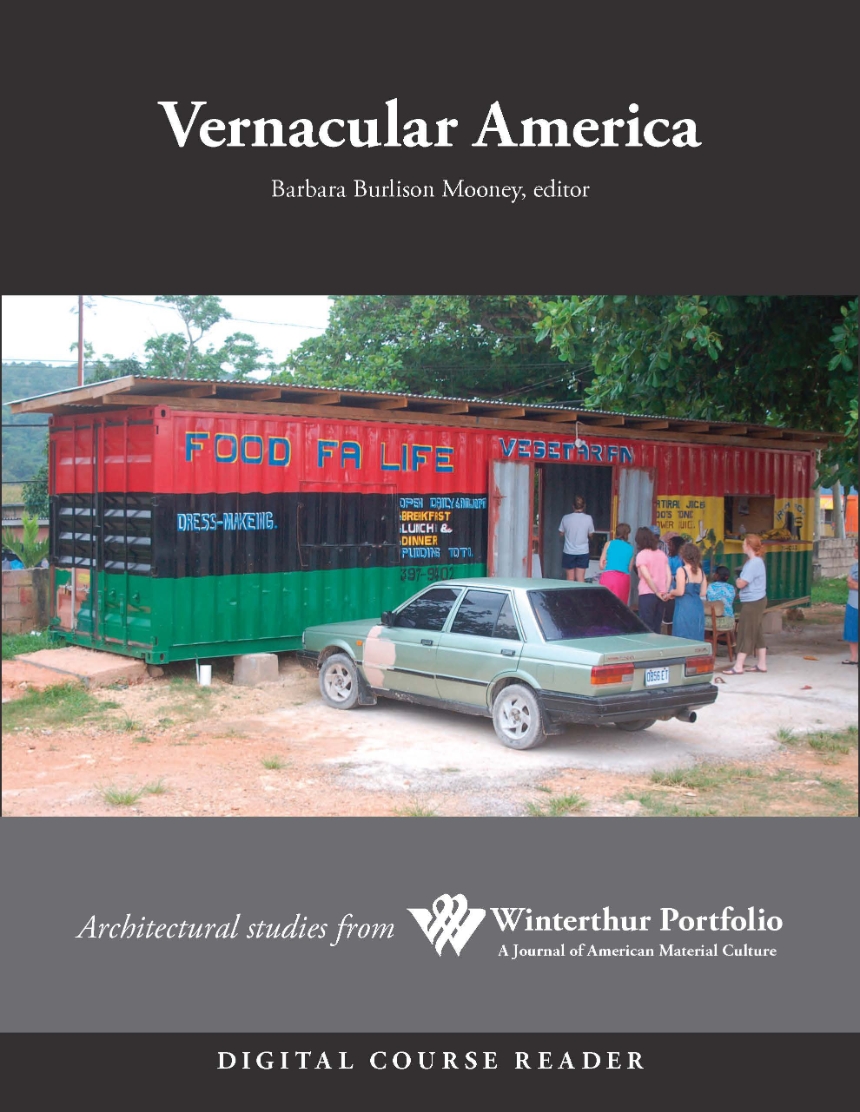Vernacular America
Architectural Studies from Winterthur Portfolio
For many students, vernacular architecture represents a novel approach to the study of the built environment. Even after several decades of intellectual embrace, many professors of art and architectural history continue to find it difficult to integrate vernacular architecture into a course syllabus. Instructors face a daunting task: how can a more expansive, nuanced picture of the history of the American built environment be taught when standard textbooks continue to privilege the same monuments decade after decade without acknowledging the richness of the American architectural legacy? Vernacular America, selected from three decades of Winterthur Portfolio articles on the subject, addresses that problem by suggesting practical strategies for balancing, and perhaps even undermining, the canon of American architecture as it is taught in many college classrooms.
Many instructors of New World architectural history seek to bring broad social, ethnic, political, and technical perspectives to the study of the built environment. While they await a survey book that fully integrates academic and vernacular narratives, the articles in this course reader are intended to encourage instructors and students to incorporate a diverse and inclusive approach into the curriculum, one that continues to understand the past, but also one that pays attention to the future. The aim of this publication is to offer both instructors and students the opportunity to create and nurture a more comprehensive picture of the history of the built environment of the United States.
Barbara Burlison Mooney is associate professor of art history at the University of Iowa. Professor Mooney’s area of specialization encompasses both American architecture and African American art.
Many instructors of New World architectural history seek to bring broad social, ethnic, political, and technical perspectives to the study of the built environment. While they await a survey book that fully integrates academic and vernacular narratives, the articles in this course reader are intended to encourage instructors and students to incorporate a diverse and inclusive approach into the curriculum, one that continues to understand the past, but also one that pays attention to the future. The aim of this publication is to offer both instructors and students the opportunity to create and nurture a more comprehensive picture of the history of the built environment of the United States.
Barbara Burlison Mooney is associate professor of art history at the University of Iowa. Professor Mooney’s area of specialization encompasses both American architecture and African American art.
Table of Contents
General Introduction
Barbara Burlison Mooney
Impermanent Architecture in the Southern American Colonies
Cary Carson, Norman F. Barka, William M. Kelso, Garry Wheeler Stone, and Dell Upton
The Planter’s Prospect: Houses, Outbuildings, and Rural Landscapes in Eighteenth-Century Virginia
Camille Wells
The Origins of Creole Architecture
Jay D. Edwards
Pattern Books and Professionalism Aspects of the Transformation of Domestic Architecture in America, 1800–1860
Dell Upton
The Pennsylvania German House: European Antecedents and New World Forms
William Woys Weaver
German American Log Buildings of Dubois County, Indiana
Warren E. Roberts
Fachwerk Construction in the German Settlements of Wisconsin
William H. Tishler
Looking for History’s Huts
Barbara Burlison Mooney
Urban Vernacular Architecture in Nineteenth-Century Baltimore
Mary Ellen Hayward
Mail-Order House Plans and American Victorian Architecture
James L. Garvin
“A Workingman’s Paradise”: The Evolution of an Unplanned Suburban Landscape
Anne E. Krulikowski
Women on the Home Front: Hostess Houses during World War I
Cynthia Brandimarte
The American Colonial Revival in the 1930s
David Gebhard
The Architectures of Black Identity: Buildings, Slavery, and Freedom in the Caribbean and the American South
Louis P. Nelson
Barbara Burlison Mooney
Impermanent Architecture in the Southern American Colonies
Cary Carson, Norman F. Barka, William M. Kelso, Garry Wheeler Stone, and Dell Upton
The Planter’s Prospect: Houses, Outbuildings, and Rural Landscapes in Eighteenth-Century Virginia
Camille Wells
The Origins of Creole Architecture
Jay D. Edwards
Pattern Books and Professionalism Aspects of the Transformation of Domestic Architecture in America, 1800–1860
Dell Upton
The Pennsylvania German House: European Antecedents and New World Forms
William Woys Weaver
German American Log Buildings of Dubois County, Indiana
Warren E. Roberts
Fachwerk Construction in the German Settlements of Wisconsin
William H. Tishler
Looking for History’s Huts
Barbara Burlison Mooney
Urban Vernacular Architecture in Nineteenth-Century Baltimore
Mary Ellen Hayward
Mail-Order House Plans and American Victorian Architecture
James L. Garvin
“A Workingman’s Paradise”: The Evolution of an Unplanned Suburban Landscape
Anne E. Krulikowski
Women on the Home Front: Hostess Houses during World War I
Cynthia Brandimarte
The American Colonial Revival in the 1930s
David Gebhard
The Architectures of Black Identity: Buildings, Slavery, and Freedom in the Caribbean and the American South
Louis P. Nelson
